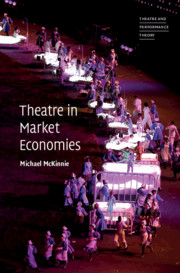Book contents
- Theatre in Market Economies
- Theatre and Performance Theory
- Theatre in Market Economies
- Copyright page
- Dedication
- Contents
- Figures
- Acknowledgements
- Introduction Show Business
- Chapter 1 Industry
- Chapter 2 Productivity
- Chapter 3 Citizenship
- Chapter 4 Security
- Chapter 5 Confidence
- Conclusion
- Notes
- Bibliography
- Index
Chapter 5 - Confidence
Published online by Cambridge University Press: 12 February 2021
- Theatre in Market Economies
- Theatre and Performance Theory
- Theatre in Market Economies
- Copyright page
- Dedication
- Contents
- Figures
- Acknowledgements
- Introduction Show Business
- Chapter 1 Industry
- Chapter 2 Productivity
- Chapter 3 Citizenship
- Chapter 4 Security
- Chapter 5 Confidence
- Conclusion
- Notes
- Bibliography
- Index
Summary
Chapter 5 examines the role of theatre in creating economic confidence during a time of austerity. It focuses on Isles of Wonder, the theatrical performance at the heart of the opening ceremony of the 2012 Olympics in London. Isles of Wonder was an astonishingly confident performance but, more importantly, it was an exhilarating show of confidence, at a time when the UK government was imposing a strict programme of economic austerity. But this show was as much an economic one as a theatrical one, and a deeply ambigous one politically. On the one hand, Isles of Wonder contained a stirring theatrical tribute to social welfare and appeared to be a theatrical metonym of Keynesian forms of public investment and productivity. On the other hand, Isles of Wonder successfully mobilised rentier forms of Olympic infrastructure that was a travesty of that Keynesianism. Isles of Wonder demonstrated the remarkable and disorienting ability of performance to refigure what might otherwise be political economic antagonisms into a theatrically and economically productive dialectic, if only for a short – but nonetheless spectacular – while.
Keywords
- Type
- Chapter
- Information
- Theatre in Market Economies , pp. 138 - 154Publisher: Cambridge University PressPrint publication year: 2021

